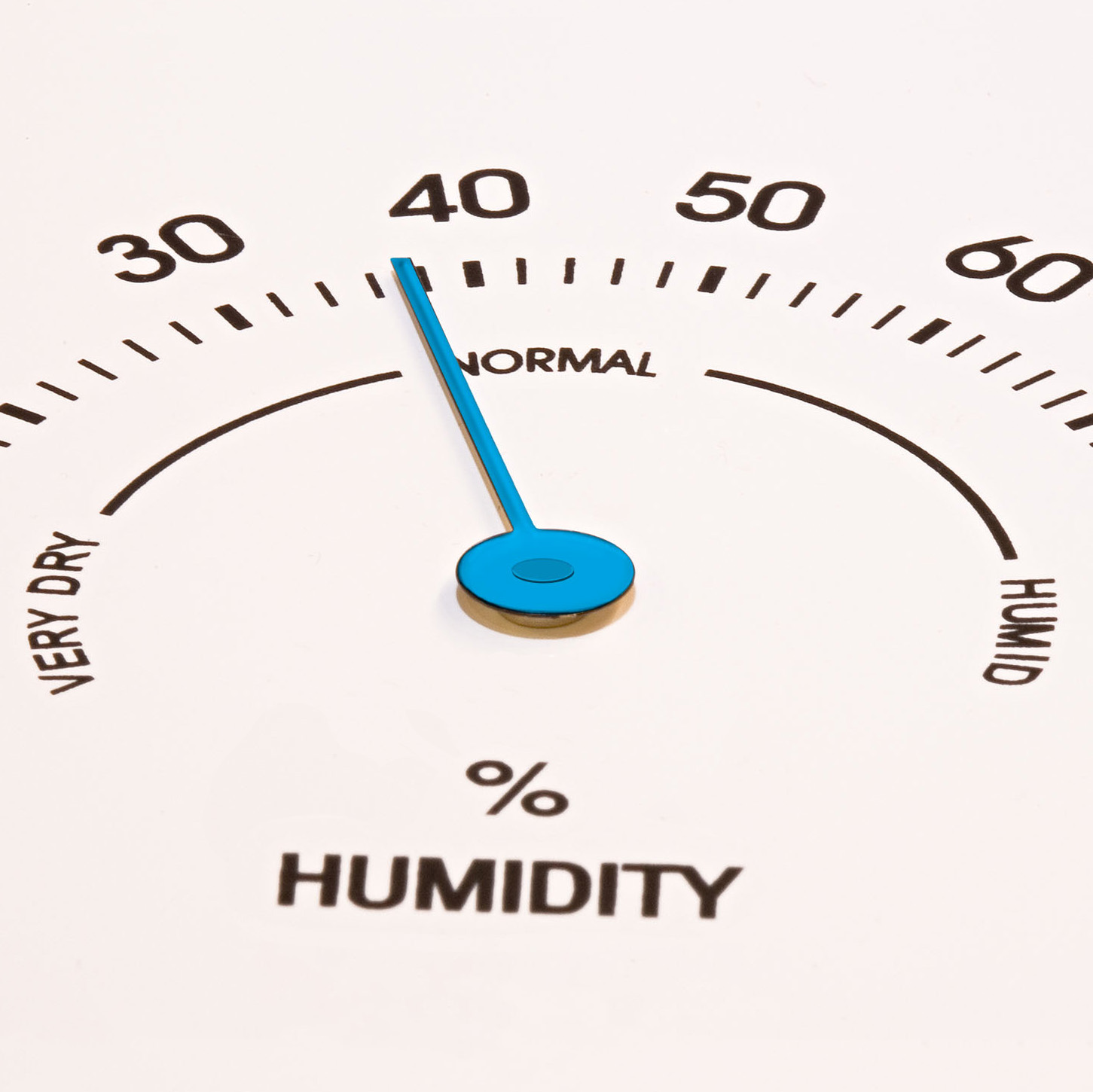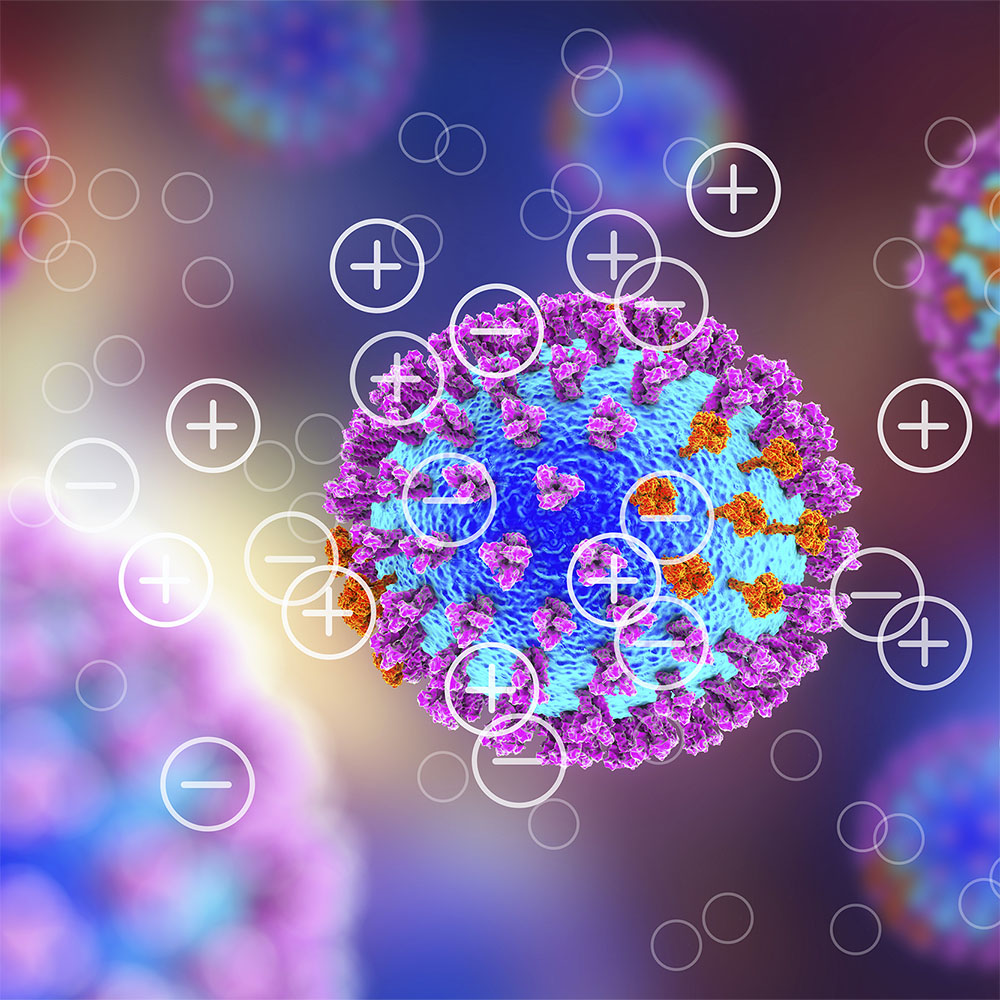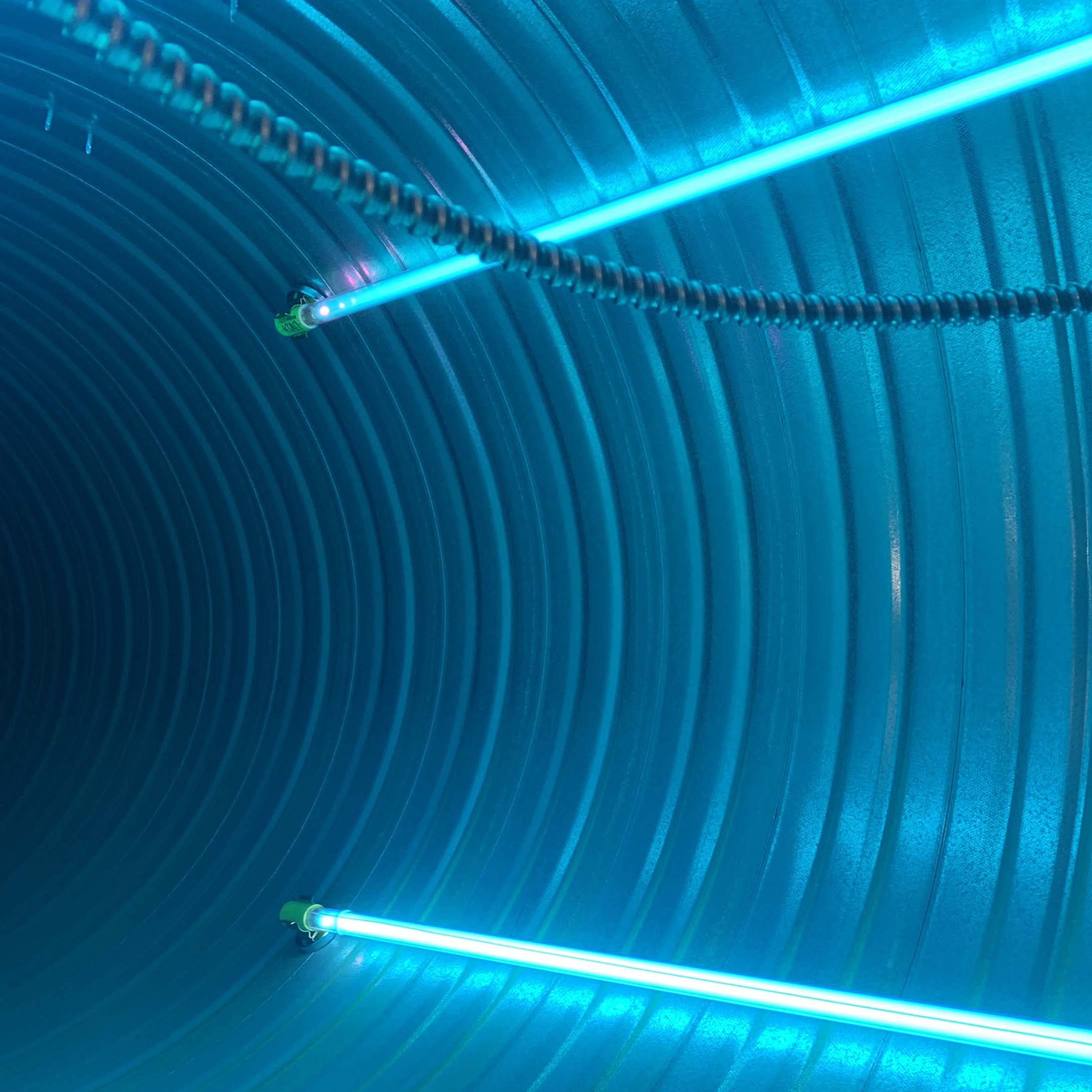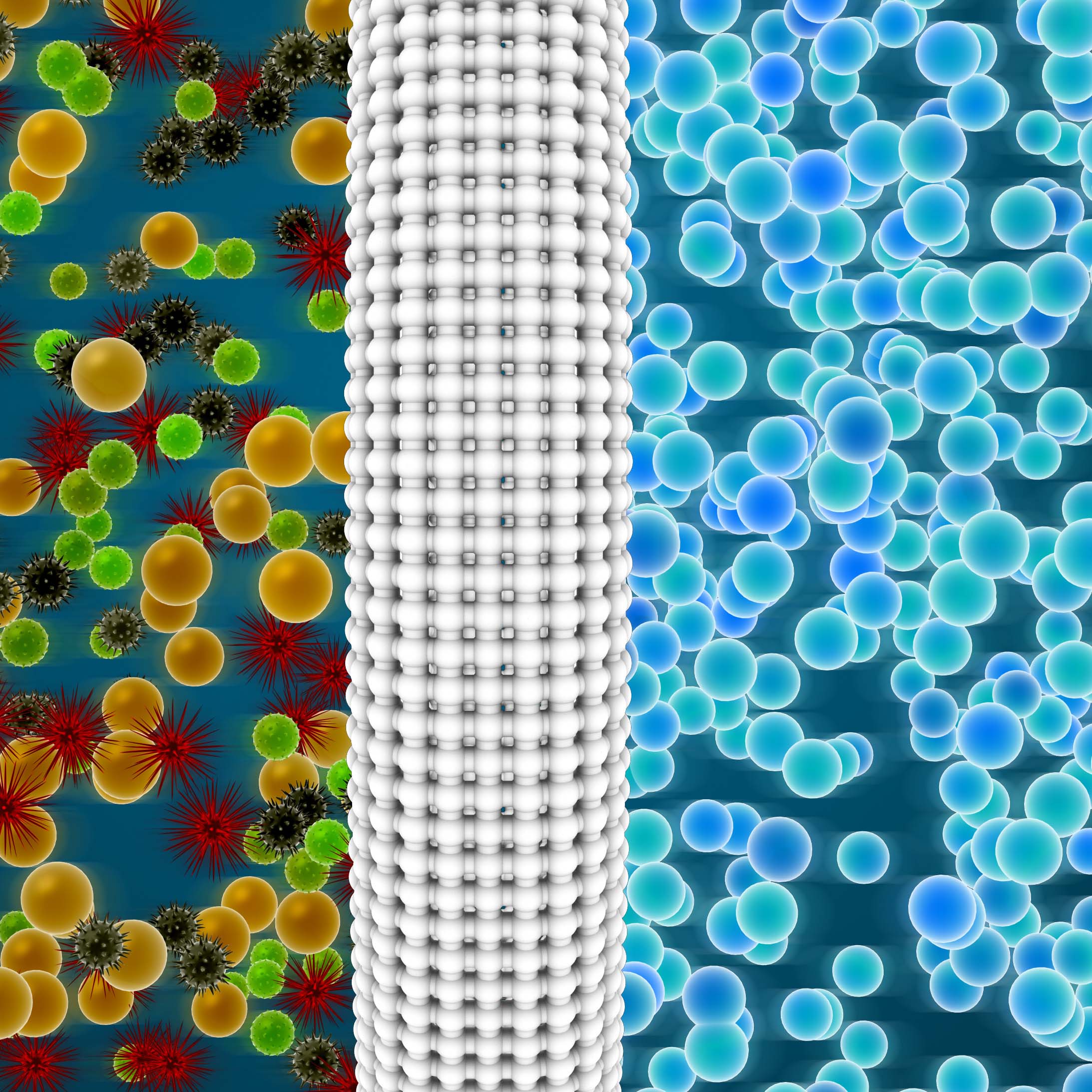
Circadian Lighting Systems
COVID White Paper Series-08
 David Van der Vossen, PE
David Van der Vossen, PE
Senior VP of Engineering
LEED AP BD+C, CGD
Next in the Allen + Shariff COVID-19 series is our investigation into the studies on circadian lighting systems and their possible benefits in reducing viral transmission. Many of us have sat through presentations and sales meetings touting the marvels of tunable LED and circadian lighting. With this influx of marketing, this week’s white paper dives into the detailed studies to see if they support the lighting industry pitch.
Circadian Rhythm
“Circadian rhythms are physical, mental, and behavioral changes that follow a 24-hour cycle. These natural processes respond primarily to light and dark and affect most living things, including animals, plants, and microbes” (Ref: Circadian Rhythms (nih.gov)) Melatonin is a hormone produced in the body. Its production helps your body to know when it is time to sleep and to wake up. Normally, your body makes more melatonin at night. Levels usually begin to elevate in the evening once the sun sets. They drop in the morning when the sun comes up. Melatonin production is directly affected by light. When less light is present, you produce more melatonin. This increased production of the hormone makes an individual feel drowsier. Healthy circadian rhythms lead to better sleep patterns.
“Recent research has shown that there is also a non-visual aspect of light that helps to regulate biological processes, including people’s circadian rhythms. Studies have shown that light needed to stimulate a person’s circadian system – enough to synchronize it with the 24-hour day, is at least 10,000 times greater than the amount needed to stimulate a person’s visual system. The circadian system is maximally sensitive to short-wavelength (blue) light while the visual system is most sensitive to longer wavelength light.
As a result, just because a person may have enough light to see the things around them does not mean that they are receiving light of the correct spectrum or intensity of light to beneficially impact their circadian rhythm.” (Ref: Circadian Light – GSA Sustainable Facilities Tool (sftool.gov)
Much of the science associated with circadian rhythms and lighting focus around “circadian stimulus or CS.” CS is the measurement that has been developed to provide a metric for circadian stimulus by the Lighting Research Center (LRC). (Ref: LDA_CircadianStimulus_Oct2016.pdf (rpi.edu)) CS looks at the appropriate amount and type of lighting required to stimulate melatonin production.
Sleep, Health and Viruses
A 2015 study published in the Journal: Sleep investigated the effect of sleep and the ability to fight off the common cold. (Ref: Sleeping Less Dramatically Raises Your Risk for Getting Sick | Time) Individuals who slept only four and a half hours a night, compared to six hours a night, were over 16 times more likely to get sick. Interestingly enough, those disparities increased even more with only slightly more sleep. Individuals who slept seven hours a night were four times more likely to get sick compared to those who slept only six hours. The study was able to make a direct correlation between sleep amounts and the body’s ability to fight off colds.
An article in Psychology Today spells out in more detail how improved sleep patterns help the body to fight off illnesses, including COVID-19, by increasing T-cells production and cytokine proteins. (Ref: How You Can Use Sleep to Fight Back Against Coronavirus | Psychology Today)
Daylighting
A collection of daylighting studies conducted by the GSA displayed differing results. Studies done in the Mid-Atlantic region of the United States indicated beneficial sleep and health outcomes for occupants that worked in spaces with natural daylighting. (Ref: Daylighting Research at 1800 F Street | GSA) However, similar studies conducted in Seattle and Portland did not display the same results, and there did not seem to be any notable benefits from increased natural daylight exposure. (Ref: Results Report: Measuring Personal Light Exposures, Mood, and Sleep Quality — Federal Center South, Seattle, Washington (rpi.edu)) (Ref: Measuring Personal Light Exposures, Health, and Wellbeing Outcomes, Edith Green Wendell Wyatt Federal Building, Portland, Oregon (rpi.edu)) Based on these studies, the GSA concluded that properly engineered daylighting may have beneficial health outcomes. (Ref: Circadian Light For Your Health | GSA)
Another study conducted by Cornell University indicated health benefits to include less eye strain, headaches and more alertness for individuals who are exposed to greater amounts of daylight. (Ref: Hedge A and Nou D. Worker Reactions to Electrochromic and Low e Glass Office Windows. Ergonomics Int J 2018, 2(4): 000166. (medwinpublishers.com) Additional studies have also shown improved mood, productivity, and test scores. (Ref: Find out why people perform better in daylight environments (velux.com))
While all of these studies do not perfectly align with their outcomes, the vast majority lean towards a variety of beneficial outcomes from daylight exposure. The current production wave of tunable LED systems by lighting manufacturers intends to match the health outcomes of daylighting by creating a similar experience with electric lighting systems.
Tunable LED
The current wave of LED technology attempts to mimic the color temperatures of daylighting in order to directly influence the amount of melatonin produced by the body. The intent is to vary both the intensity and color temperature of lighting throughout the workday to closely match that of natural daylighting.
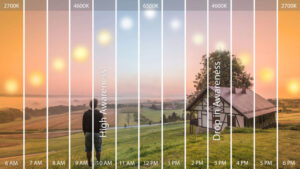
https://www.thelightingpractice.com/what-is-circadian-lighting/
The color temperature of daylighting varies from 2700 Kelvin in the morning, to 6200 Kelvin at midday, and back to 2700 Kelvin in the later afternoon. Comparably, most indoor spaces are designed with electric light at a fixed 3000 Kelvin or 3500 Kelvin. Daylight intensity also varies throughout the day. Daylight at sunrise produces an intensity at about 400 lux, while noon-day sun produces nearly 120,000 lux, and a reduction back to 400 lux at sunset.
To mimic daylight with electric light, manufacturers have developed LEDs and controls that can not only shift their color temperature as the day progresses, but they can also vary the amount of light intensity delivered. By doing so, the electric light can further regulate melatonin levels and hopefully produce more energy during the day, and restful sleep at night.
LED Studies
A 2016 LRC/GSA study researched the effect of placing LED lights on the desks of 36 participants over three days. These participants were surveyed with the results noting increased alertness and vitality with the introduction of the LED lights. (Ref: Microsoft Word – VA_FHWA_Final_Report_14_July_2017.docx (rpi.edu))
In a second study, the LRC and GSA teamed together to look at the effect of providing blue lighting in the morning, white light midday, and red light in the afternoon. Conducted over a period of three weeks with only 20 participants, the survey participants noted that they went to bed earlier, woke up earlier and felt more alert in the afternoon. (Ref: DOS_2018.pdf (rpi.edu))
On the flip side, several studies show that LED lights that generate too much blue-rich white light (high Kelvin temperatures) actually have detrimental health effects including increased risk for cancer, diabetes, cardiovascular disease and are also five times more likely to disrupt our sleep cycle. (Ref: AMA Report Affirms Human Health Impacts from LEDs | International Dark-Sky Association (darksky.org)) It is, therefore, very important to use a properly designed LED lighting system when attempting to alter the hormones of the human body.
Tying the Dots Together
From all the studies conducted over the years, what can we deduce from their findings?
1. Sleep is affected by circadian rhythms and exposure to light.
2. Health outcomes and our ability to fight off sickness are improved by better sleep.
3. Improving daylighting exposure has been shown to improve sleep patterns and have other beneficial health outcomes.
4. The two small LRC/GSA studies, with a limited number of participants and over very short timeframes, noted more alertness and better sleep patterns with tunable LED lights. These studies are not as rigorous as typically required for definitive results.
5. Allen + Shariff could not locate any significant tunable LED lighting studies that show substantial beneficial health outcomes similar to the breadth of studies that exist for daylighting.
While we cannot conclude that tunable LED circadian lighting does not have beneficial health outcomes, it is our opinion that the science and studies are not advanced enough to draw the conclusion that circadian lighting and tunable LEDs definitively improve sleep and health. For lighting manufacturers to state that LED circadian lighting helps to fight off illnesses such as COVID-19 is probably a bridge too far. Hopefully, in the near future, a more in-depth study will be performed, and tunable LEDs can evolve to aid us all to sleep better and to be healthier.
Engineering Tomorrow
At Allen + Shariff, we believe in providing innovative and efficient MEP engineering solutions to our clients. Contact us for more information on our ongoing blog series, to participate in a registered AIA seminar, or learn more about how you can partner with our team.
Contact Dave Van der Vossen at 910-218-3856 for details.
COVID-19 White Paper Series

Circadian Lighting Systems
COVID White Paper Series-08
 David Van der Vossen, PE
David Van der Vossen, PE
Senior VP of Engineering
LEED AP BD+C, CGD
Next in the Allen + Shariff COVID-19 series is our investigation into the studies on circadian lighting systems and their possible benefits in reducing viral transmission. Many of us have sat through presentations and sales meetings touting the marvels of tunable LED and circadian lighting. With this influx of marketing, this week’s white paper dives into the detailed studies to see if they support the lighting industry pitch.
Circadian Rhythm
“Circadian rhythms are physical, mental, and behavioral changes that follow a 24-hour cycle. These natural processes respond primarily to light and dark and affect most living things, including animals, plants, and microbes” (Ref: Circadian Rhythms (nih.gov)) Melatonin is a hormone produced in the body. Its production helps your body to know when it is time to sleep and to wake up. Normally, your body makes more melatonin at night. Levels usually begin to elevate in the evening once the sun sets. They drop in the morning when the sun comes up. Melatonin production is directly affected by light. When less light is present, you produce more melatonin. This increased production of the hormone makes an individual feel drowsier. Healthy circadian rhythms lead to better sleep patterns.
“Recent research has shown that there is also a non-visual aspect of light that helps to regulate biological processes, including people’s circadian rhythms. Studies have shown that light needed to stimulate a person’s circadian system – enough to synchronize it with the 24-hour day, is at least 10,000 times greater than the amount needed to stimulate a person’s visual system. The circadian system is maximally sensitive to short-wavelength (blue) light while the visual system is most sensitive to longer wavelength light.
As a result, just because a person may have enough light to see the things around them does not mean that they are receiving light of the correct spectrum or intensity of light to beneficially impact their circadian rhythm.” (Ref: Circadian Light – GSA Sustainable Facilities Tool (sftool.gov)
Much of the science associated with circadian rhythms and lighting focus around “circadian stimulus or CS.” CS is the measurement that has been developed to provide a metric for circadian stimulus by the Lighting Research Center (LRC). (Ref: LDA_CircadianStimulus_Oct2016.pdf (rpi.edu)) CS looks at the appropriate amount and type of lighting required to stimulate melatonin production.
Sleep, Health and Viruses
A 2015 study published in the Journal: Sleep investigated the effect of sleep and the ability to fight off the common cold. (Ref: Sleeping Less Dramatically Raises Your Risk for Getting Sick | Time) Individuals who slept only four and a half hours a night, compared to six hours a night, were over 16 times more likely to get sick. Interestingly enough, those disparities increased even more with only slightly more sleep. Individuals who slept seven hours a night were four times more likely to get sick compared to those who slept only six hours. The study was able to make a direct correlation between sleep amounts and the body’s ability to fight off colds.
An article in Psychology Today spells out in more detail how improved sleep patterns help the body to fight off illnesses, including COVID-19, by increasing T-cells production and cytokine proteins. (Ref: How You Can Use Sleep to Fight Back Against Coronavirus | Psychology Today)
Daylighting
A collection of daylighting studies conducted by the GSA displayed differing results. Studies done in the Mid-Atlantic region of the United States indicated beneficial sleep and health outcomes for occupants that worked in spaces with natural daylighting. (Ref: Daylighting Research at 1800 F Street | GSA) However, similar studies conducted in Seattle and Portland did not display the same results, and there did not seem to be any notable benefits from increased natural daylight exposure. (Ref: Results Report: Measuring Personal Light Exposures, Mood, and Sleep Quality — Federal Center South, Seattle, Washington (rpi.edu)) (Ref: Measuring Personal Light Exposures, Health, and Wellbeing Outcomes, Edith Green Wendell Wyatt Federal Building, Portland, Oregon (rpi.edu)) Based on these studies, the GSA concluded that properly engineered daylighting may have beneficial health outcomes. (Ref: Circadian Light For Your Health | GSA)
Another study conducted by Cornell University indicated health benefits to include less eye strain, headaches and more alertness for individuals who are exposed to greater amounts of daylight. (Ref: Hedge A and Nou D. Worker Reactions to Electrochromic and Low e Glass Office Windows. Ergonomics Int J 2018, 2(4): 000166. (medwinpublishers.com) Additional studies have also shown improved mood, productivity, and test scores. (Ref: Find out why people perform better in daylight environments (velux.com))
While all of these studies do not perfectly align with their outcomes, the vast majority lean towards a variety of beneficial outcomes from daylight exposure. The current production wave of tunable LED systems by lighting manufacturers intends to match the health outcomes of daylighting by creating a similar experience with electric lighting systems.
Tunable LED
The current wave of LED technology attempts to mimic the color temperatures of daylighting in order to directly influence the amount of melatonin produced by the body. The intent is to vary both the intensity and color temperature of lighting throughout the workday to closely match that of natural daylighting.

https://www.thelightingpractice.com/what-is-circadian-lighting/
The color temperature of daylighting varies from 2700 Kelvin in the morning, to 6200 Kelvin at midday, and back to 2700 Kelvin in the later afternoon. Comparably, most indoor spaces are designed with electric light at a fixed 3000 Kelvin or 3500 Kelvin. Daylight intensity also varies throughout the day. Daylight at sunrise produces an intensity at about 400 lux, while noon-day sun produces nearly 120,000 lux, and a reduction back to 400 lux at sunset.
To mimic daylight with electric light, manufacturers have developed LEDs and controls that can not only shift their color temperature as the day progresses, but they can also vary the amount of light intensity delivered. By doing so, the electric light can further regulate melatonin levels and hopefully produce more energy during the day, and restful sleep at night.
LED Studies
A 2016 LRC/GSA study researched the effect of placing LED lights on the desks of 36 participants over three days. These participants were surveyed with the results noting increased alertness and vitality with the introduction of the LED lights. (Ref: Microsoft Word – VA_FHWA_Final_Report_14_July_2017.docx (rpi.edu))
In a second study, the LRC and GSA teamed together to look at the effect of providing blue lighting in the morning, white light midday, and red light in the afternoon. Conducted over a period of three weeks with only 20 participants, the survey participants noted that they went to bed earlier, woke up earlier and felt more alert in the afternoon. (Ref: DOS_2018.pdf (rpi.edu))
On the flip side, several studies show that LED lights that generate too much blue-rich white light (high Kelvin temperatures) actually have detrimental health effects including increased risk for cancer, diabetes, cardiovascular disease and are also five times more likely to disrupt our sleep cycle. (Ref: AMA Report Affirms Human Health Impacts from LEDs | International Dark-Sky Association (darksky.org)) It is, therefore, very important to use a properly designed LED lighting system when attempting to alter the hormones of the human body.
Tying the Dots Together
From all the studies conducted over the years, what can we deduce from their findings?
1. Sleep is affected by circadian rhythms and exposure to light.
2. Health outcomes and our ability to fight off sickness are improved by better sleep.
3. Improving daylighting exposure has been shown to improve sleep patterns and have other beneficial health outcomes.
4. The two small LRC/GSA studies, with a limited number of participants and over very short timeframes, noted more alertness and better sleep patterns with tunable LED lights. These studies are not as rigorous as typically required for definitive results.
5. Allen + Shariff could not locate any significant tunable LED lighting studies that show substantial beneficial health outcomes similar to the breadth of studies that exist for daylighting.
While we cannot conclude that tunable LED circadian lighting does not have beneficial health outcomes, it is our opinion that the science and studies are not advanced enough to draw the conclusion that circadian lighting and tunable LEDs definitively improve sleep and health. For lighting manufacturers to state that LED circadian lighting helps to fight off illnesses such as COVID-19 is probably a bridge too far. Hopefully, in the near future, a more in-depth study will be performed, and tunable LEDs can evolve to aid us all to sleep better and to be healthier.
Engineering Tomorrow
At Allen + Shariff, we believe in providing innovative and efficient MEP engineering solutions to our clients. Contact us for more information on our ongoing blog series, to participate in a registered AIA seminar, or learn more about how you can partner with our team.
Contact Dave Van der Vossen at 910-218-3856 for details.




